- 1Department of Exercise and Health Sciences, University of Taipei, Taipei, Taiwan
- 2Exercise and Health Promotion Association, New Taipei City, Taiwan
- 3College of Health and Medicine, School of Health Sciences, University of Tasmania, Hobart, TAS, Australia
- 4Escola Superior Desporto e Lazer, Instituto Politécnico de Viana do Castelo, Viana do Castelo, Portugal
- 5The Research Centre in Sports Sciences, Health Sciences and Human Development, Vila Real, Portugal
- 6School of Health and Human Sciences, Southern Cross University, Lismore, NSW, Australia
- 7Department of Medical Research, Taipei Veterans General Hospital, Taipei, Taiwan
- 8Department of Medicine, Taian Hospital, Taipei, Taiwan
- 9Tanyu Research Laboratory, Taipei, Taiwan
- 10Instituto de Telecomunicações, Delegação da Covilhã, Lisboa, Portugal
Background: Monitoring the daily change in resting heart rate variability (HRV) can provide information regarding training adaptation and recovery status of the autonomic nervous system (ANS) during training camps. However, it remains unclear whether postural stabilization is essential for valid and reliable ultra-short-term (HRVUST) recordings in short-term overseas training camps.
Design: Observational and longitudinal study.
Purpose: This study aimed to investigate ultra-short-term heart rate variability recordings under stabilization or post-stabilization periods in four overseas training camps.
Participant: Twenty-seven U-20 male national team futsal players voluntarily participated in this study.
Method: Resting HRV was evaluated for 10 min during the early morning of each training camp. The natural logarithm of the root mean square of successive normal-to-normal interval differences (LnRMSSD) was used for comparisons. Time segments of HRV were divided into two periods with three measures within each: (1) the first 30-s (1st_30 s LnRMSSD), the first 60-s (1st_60 s LnRMSSD), and the 5-min standard (1st_5 min LnRMSSD) during stabilization; (2) the first 30-s (2nd_30 s LnRMSSD), the first 60-s (2nd_60 s LnRMSSD), and the 5-min standard (2nd_5 min LnRMSSD) after stabilization.
Result: The results demonstrated trivial to small ES (−0.03; 0.46), very large to nearly perfect ICC (0.76; 0.98), and narrow range of SEM (0.06; 0.31) when all time segments of HRVUST were compared to the 1st_5 min and 2nd_5 min HRV. Furthermore, the magnitude of the correlation coefficients ranged from very high to nearly perfect for all the time segments (r = 0.83; 0.97). The HRVUST posted excellent agreement in all time segments (bias = −0.05; 0.12) with/without postural stabilization. Trivial to small levels of effect size in all time segments of LnRMSSDmean (0.02; 0.41 ES) and LnRMSSDcv (−0.49; −0.02 ES) across overseas training camps was identified.
Conclusion: The first 30 or 60-s LnRMSSD recordings can be used to evaluate daily cardiac-autonomic function during overseas training camps in futsal players. The process for stabilization seems to be unnecessary for measuring the morning resting LnRMSSD in overseas training camps among young adult futsal players.
Introduction
Heart rate (HR) variability (HRV) is a neurophysiological marker that reflects the cardiac-related activation regulated by the autonomic nervous system (ANS) (Buchheit, 2014). Assessment of HRV requires recording a time series of HR beat-to-beat intervals (R wave-to-R wave interval, RRI) via a non-invasive electrocardiographic device (ECG) or a HR monitor sensor. The measurement of HRV can help sports practitioners and coaches interpret autonomic function in terms of training adaptations (i.e. increase in RRI is associated with improvement of aerobic capacity) (Sandercock et al., 2005; Plews et al., 2013a), recovery status (Buchheit et al., 2007; Nakamura et al., 2009; Chen et al., 2019), and autonomic health during international competitions (Flatt and Howells, 2019; Flatt et al., 2019; Muñoz-López et al., in press).
The standard process to collect HRV data requires a 5-min short-term recording period preceded by a 5-min stabilization period (Task Force of the European Society of Cardiology the North American Society of Pacing Electrophysiology., 1996). However, this assessment method is limited to specific circumstances, i.e., during traditional training schedules, due to the time-consuming nature of this type of assessment. Yet, with recent methodological developments, the assessment of ultra-short-term HRV (HRVUST), HRV recording of <60 s, have been established to improve the usability of this technique in field-based settings (Castaldo et al., 2019).
In a practical sense, HRVUST assessment during sports training can be used to understand cardiac modulation during exercise or physiological adaption after an acute and chronic training regime. Nakamura et al. (2015) reported excellent limits of agreement and acceptance in 1-min HRVUST(natural logarithm of the root mean square of successive normal-to-normal interval differences, LnRMSSDUST), compared to a criterion of 5-min LnRMSSD (a 5-min HRV record after 5-min stabilization). The correlation between changes in LnRMSSDUST (i.e., 0–1; 1–2; 2–3; 3–4; 4–5 min) and LnRMSSD criterion was between 0.45 and 0.75, with the highest value (r = 0.75; 90% CI: 0.55–0.85) found between LnRMSSDUST at 1–2 min and LnRMSSD criterion, indicating measurement validity and agreement of HRVUST assessment after 1-min of stabilization. In addition, Krejčí et al. (2018) compared LnRMSSDUST every 30 s in 5-min stabilization records to a 5-min criterion (6–10 min) in 30 endurance athletes at the national level (10 ski runners, 8 road cyclists, and 12 cross-country skiers) and 30 university students. When LnRMSSDUST and HR were measured in the supine position, the minimal stabilization period to stabilize both indices was 60-s for endurance athletes and 90-s for university students for valid and reliable estimations. Interestingly, Pereira et al. (2016) demonstrated excellent reliability and limits of agreement of 1-min HRVUST during 5-min stabilization in 35 elite futsal players. An additional observation in an athletic population reported by Flatt and Esco (2016) also supports this notion. However, interpretation of these findings may be limited due to the heterogeneity of the sample pools from mixed genders and training regimens. Despite the time efficiency of data collection using HRVUST, there are no standard recommendations for using HRVUST with or without stabilization.
Monitoring the daily change in resting HRV can provide information regarding training adaptation and recovery status of ANS health during national team training camps (Flatt and Howells, 2019; Flatt et al., 2019). During a national team training camp, soccer players who played more than 60 min of match play experienced augmented ANS modulation (by measuring daily morning LnRMSSD) after a friendly match. This profound effect lasting for 72 h after (Muñoz-López et al., in press). Thus, it is important to monitor the HRV parameters for assessing recovery status during training camps. It was recently observed that 30-s mean value of LnRMSSD (LnRMSSDmean) measure was accurate and valid compared to the standard 5-min LnRMSSD measure during both training camps (domestic and overseas) and international competition in a male U-20 national futsal team. In contrast, coefficient of variation of LnRMSSD (LnRMSSDcv) measure required at least 2 min recordings to provide valid and reliable HRV measures during training camps (Chen et al., 2020; Clemente F. M et al., 2020). However, the interpretation of these findings were highlighted as being after 5-min postural stabilization period.
Monitoring LnRMSSDmean and LnRMSSDcv can help us to understand the vagal-related adaptation and psychophysiological status associated with physical fitness during training period (i.e., increase in LnRMSSDmean, decrease in LnRMSSDcv, and improvement of aerobic capacity) (Nakamura et al., 2020). Most of previous studies reported agreement of HRVUST based on crossectional designs, in this study, weekly HRVUST of LnRMSSDmean and LnRMSSDcv was investigated during four overseas training camp in a male U-20 national futsal team. In light of the abovementioned studies, the purpose of this study was twofold. Firstly, to compare HRVUST recordings within stabilization and after stabilization periods during short-term overseas training camps in U-20 national futsal players as a surrogate to the traditional 5-min standard measures. Secondly, to compare the variation of HRVUST measures among short-term overseas training camps. It was hypothesized that HRVUST recordings during stabilization and after stabilization would show similar degrees of agreement and reproducibility to 5-min HRV records. The secondary hypothesis was that HRVUST would show similar characteristics among overseas training camps.
Materials and Methods
Experimental Approach to the Problem
This study was a cross-sectional and observational study. Morning resting HRV was measured in four overseas training camps prior to the Asian U-20 Futsal Championship final. The HRVUST assessment during the first 5-min (stabilization) and second 5-min (after stabilization) was compared. The time segments of HRV records were divided into the first 30-s (1st_30 s LnRMSSD), the first 60-s (1st_60 s LnRMSSD), and the 5-min recording (1st_5 min LnRMSSD) during stabilization, and the first 30-s (2nd_30 s LnRMSSD), the first 60-s (2nd_60 s LnRMSSD), and the 5-min recording (2nd_5 min LnRMSSD) after stabilization.
The number of participating players varied from camp to camp due to budgeting and logistical issues (1st training camp: 6 days, 15 players; 2nd training camp: 5 days, 20 players; 3rd training camp: 6 days, 17 players; 4th training camp: 10 days, 14 players). The players involved in the fourth oversea training camp were the final registered players for the continental tournament. All assessments were conducted during the overseas training camps prior to the 2019 Asian Football Confederation U-20 Futsal Championship Final (Tabriz, Iran). Table 1 shows detailed information regarding the schedule of four overseas training camps.
Experimental Procedure
During each oversea training camp, the players were lodged in a domestic hotel one night before international travel. All players undertook daily resting HRV measures before breakfast in the early morning during the training camps. The players were instructed to maintain a comfortable sitting position for resting HRV assessment. The players were informed to control their breathing with their preferred patterns while their eyes were closed. The morning resting HRV was recorded via an individual portable Polar HR monitor (Polar team Pro, Polar Electro, Kemple, Finland). All sensors were synced to a Polar team pro dock. All data were uploaded to a secure cloud server and then subsequently exported to a laptop for data analysis. The duration of the resting HRV assessment was 10-min. All measures were performed in a quiet and spacious meeting room between 7 a.m. and 8 a.m. in local time.
Participants
Twenty-four outfield players and three goalkeepers, male futsal players were recruited and voluntarily participated this study from Chinese Taipei U-20 national futsal team (mean ± standard deviation: age = 17.93 ± 0.87 yrs; height = 1.71 ± 0.07 m; body weight = 65.39 ± 9.39 kg; body fat = 12.54 ± 2.76 %; maximal aerobic capacity = 51.98 ± 3.07 ml.kg−1.min−1). The players signed informed consent forms and were all familiarized with experimental procedures prior to participation. The study was approved by the Human Ethics Committee of the University of Taipei (UT-IRB-2018-068) and undertaken in accordance with the Declaration of Helsinki and its later amendments in 2013.
Heart Rate Variability
A portable telemetric HR monitor system was used to record the resting HRV (Polar team Pro, Polar Electro, Kemple, Finland). Each player was issued an HR sensor and HR strap for the entire duration of the training camp. Kubios HRV analysis software (Premium version 3.2.0., Kubios, Kuopio, Finland) was used to calculate LnRMSSD. Artifact correction was set at a medium threshold level, and the window width was set at 300 s with a window overlap of 50%. Smoothing priors set at 500 Lambda were used for detrending methods (Tarvainen et al., 2014). If the percentage of ectopic beats in daily measure were >5%, then the data was excluded from the analysis.
Statistical Analyses
Descriptive data of the measured variables are presented as LnRMSSDmean or LnRMSSDcv and standard deviation (SD). Inter-differences of HRVUST to standard values was analyzed by using Cohen's d effect size (ES). The level of ES was interpreted as trivial (0.0–0.2), small (0.2–0.6), moderate (0.6–1.2), large (1.2–2.0), very large (>2.0) (Hopkins et al., 2009). For reliability analysis, interclass correlation coefficients (ICC) with a two-way random model and a single measure were used to determine relative reliability. The level of ICC values were assessed as nearly perfect (0.9–1), very large (0.70–89), large (0.50–69), moderate (0.31–49), and small (0–0.3) (Hopkins et al., 2009). Moreover, the standard error of measurement (SEM) was used to analyzed the absolute values of reliability. The SEM was calculated as (Weir, 2005). For validity analysis, the relationship of HRV recordings between each time segment were assessed via Pearson product-moment correlation coefficient (r). The magnitude of the correlation coefficients was determined as trivial (r < 0.1), small (0.1 < r < 0.3), moderate (0.3 < r < 0.5), high (0.5 < r < 0.7), very high (0.7 < r < 0.9), nearly perfect (r > 0.9), and perfect (r = 1) (Hopkins et al., 2009). In addition, Bland–Altman plots were used to evaluate the upper and lower limits of agreements among all time segments of LnRMSSD (Bland and Altman, 1986). Statistical analyses were conducted using by SPSS® Statistics version 25.0 (IBM, Armonk, NY, USA) and Microsoft Excel 2016 (Microsoft Corporation, Redmond, WA, USA).
Result
Agreement and Reliability of Ultra-Short-Term Heart Rate Variability
The daily HRV recordings from all players were compliance with full attendance during the training camps. For LnRMSSDmean, small ES and very large ICC values were found between the 1st_30 s and 1st_5 min, or 1st_30 s, and 2nd_5 min in the 2nd training camp. A similar finding was reported in the 3rd training camp, except for the ICC comparison of the 1st_30 s and 1st_5 min. Moderate ES and very large ICC values were also found between the 2nd_30 s and 1st_5 min, or the 1st_30 s and 2nd_5 min. The other comparisons showed trivial ES and nearly perfect ICC values (Table 2). For LnRMSSDcv, a wide range of ES (−0.91; −0.02) and ICC (0.23; 0.88) values were found among the overseas training camps (Table 3). In Figure 1, the results of LnRMSSDmean exhibited nearly perfect correlations in all correlations analyses except for a very high correlation between the 2nd_5 min and 1st_30 s (0.83, p < 0.001), and 2nd_5 min and 1st_60 s (0.88, p < 0.001). In Figure 2, the results of LnRMSSDcv demonstrate high (0.59–0.77, p < 0.001) to very high (0.72–0.83, p < 0.001) correlations in all comparisons.
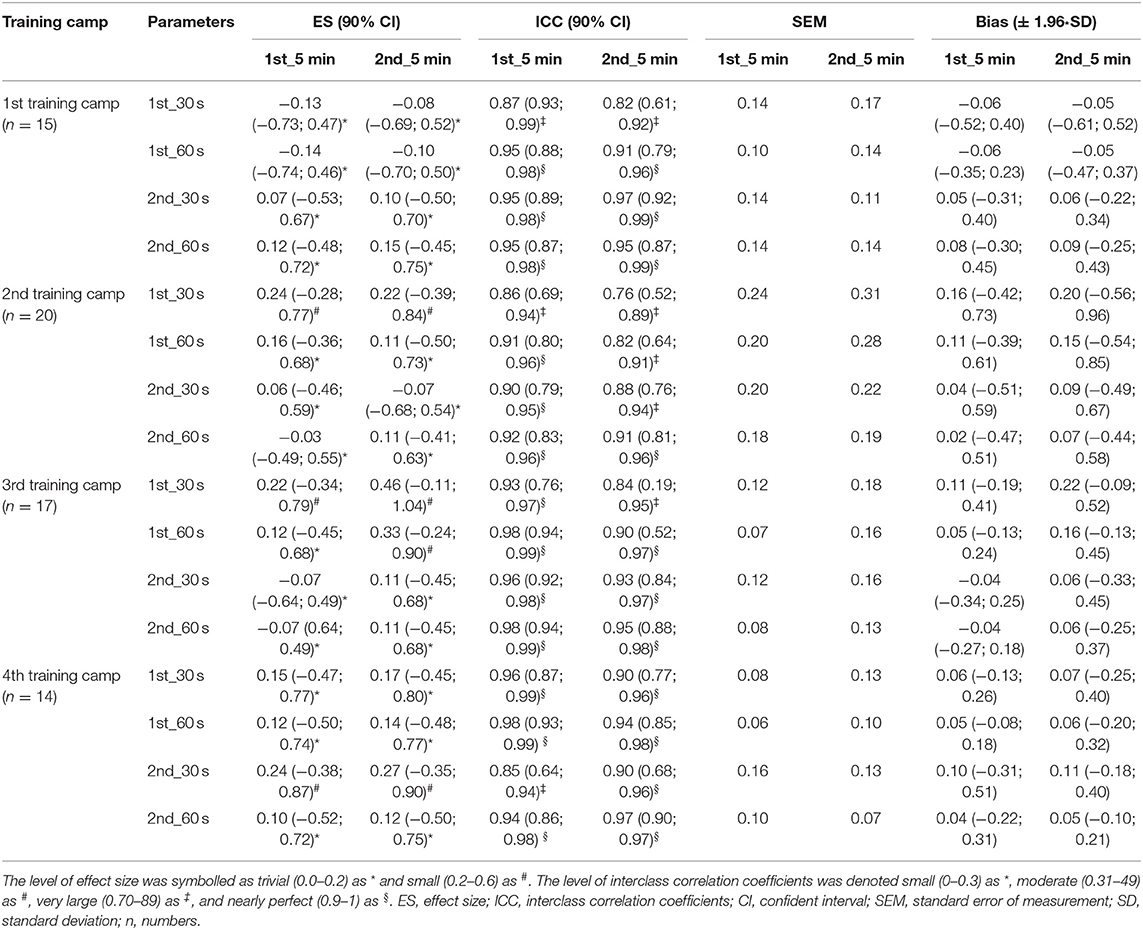
Table 2. Mean of natural logarithm of root mean square differences between adjacent normal R–R intervals (LnRMSSD) during 0–30 s, 0–60 s, and 0–5 min criterion in stabilization (1st_5 min) and after stabilization (2nd_5 min) assessments.
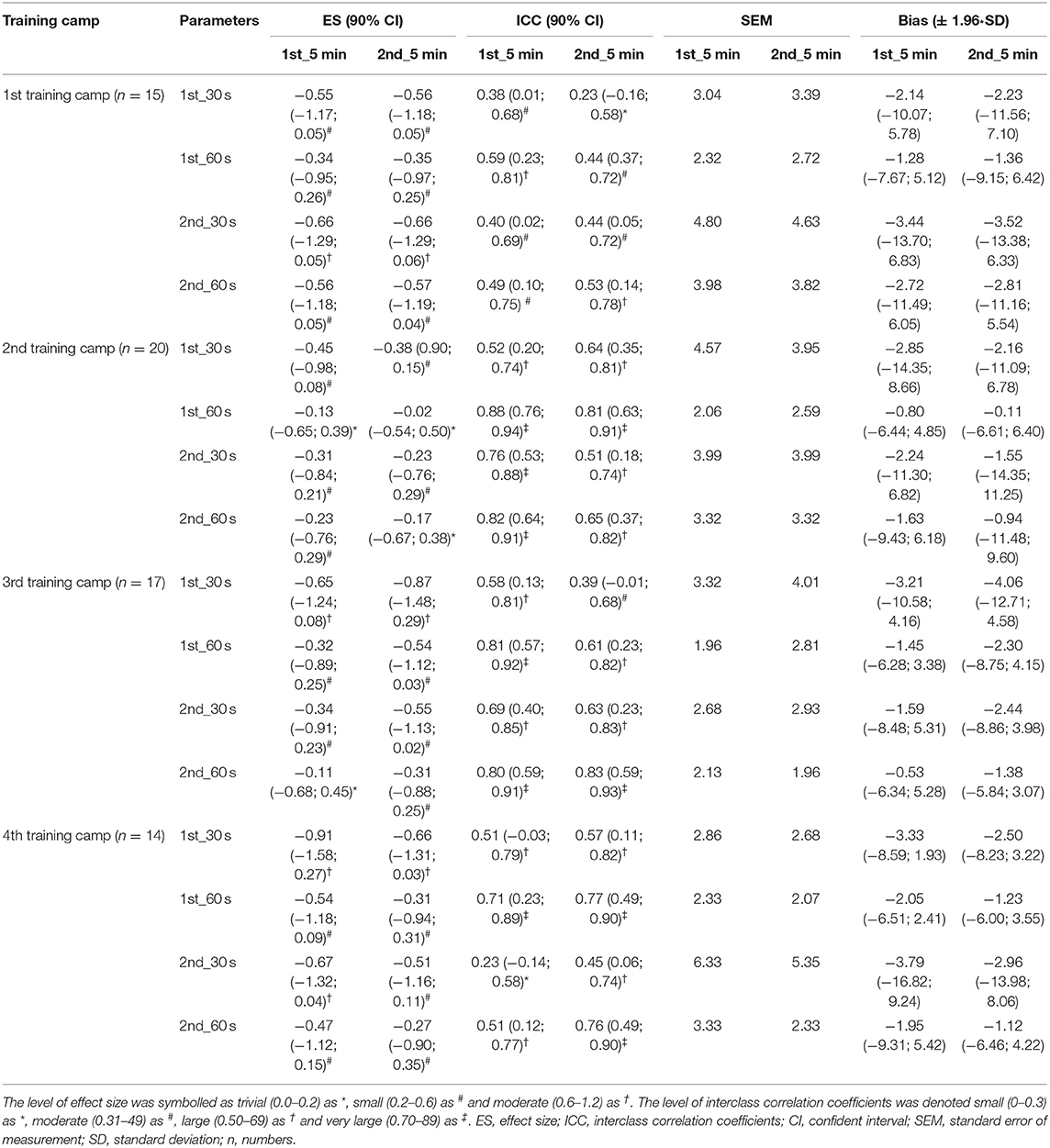
Table 3. Coefficient of variation of natural logarithm of root mean square differences between adjacent normal R–R intervals (LnRMSSD) during 0–30 s, 0–60 s, and 0–5 min criterion in stabilization (1st_5min) and after stabilization (2nd_5min) assessments.
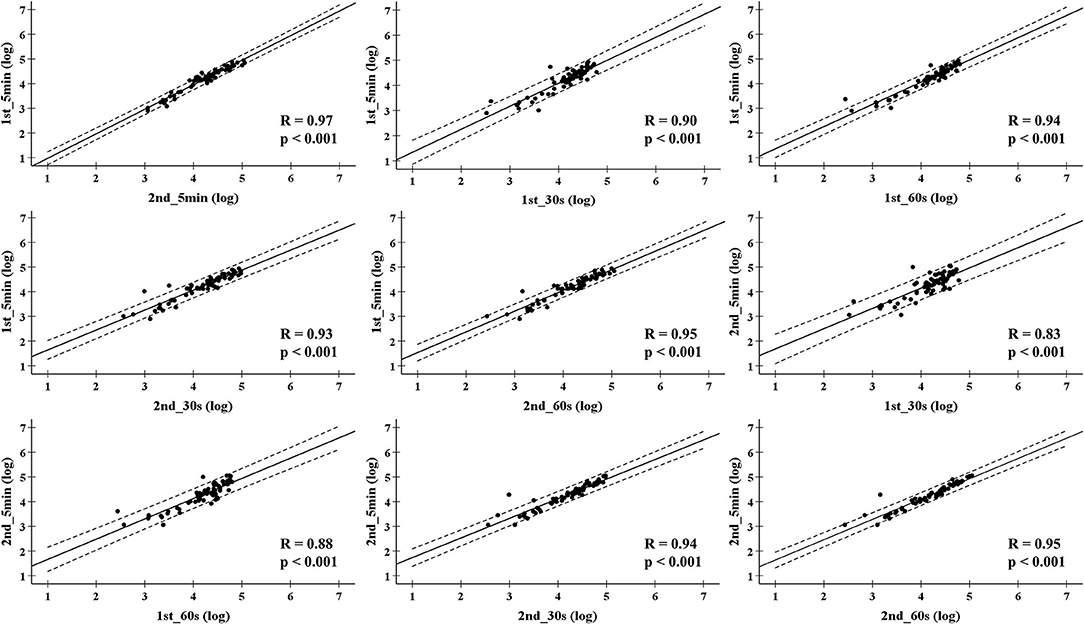
Figure 1. Pearson correlation coefficient for the mean of natural logarithm of the root mean square differences between adjacent normal R-R intervals in all time segments during four overseas training camps. 1st_5 min = The first 5-min LnRMSSD; 1st_30 s = The first 30 s LnRMSSD; 1st_60 s = The first 60 s LnRMSSD; 2nd_5 min = The 6-10 min LnRMSSD; 2nd_30 s = The secondary 30 s LnRMSSD; 2nd_60 s = The secondary 60 s LnRMSSD.
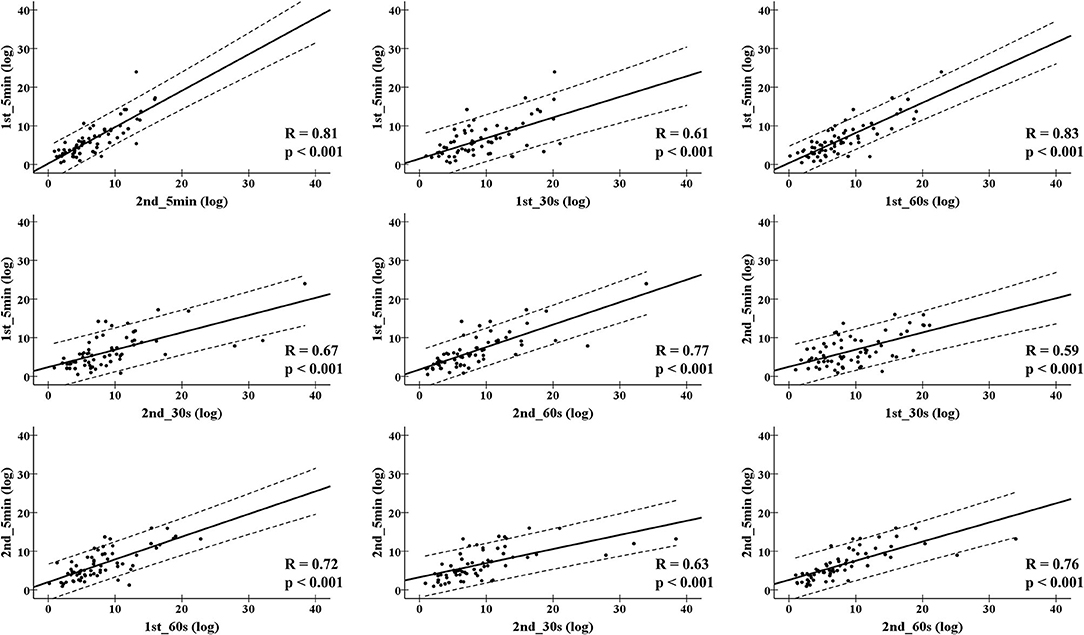
Figure 2. Pearson correlation coefficient for the coefficient of variation of natural logarithm of the root mean square differences between adjacent normal R-R intervals in all time segments during four overseas training camps. 1st_5 min = The first 5-min LnRMSSD; 1st_30 s = The first 30 s LnRMSSD; 1st_60 s = The first 60 s LnRMSSD; 2nd_5 min = The 6-10 min LnRMSSD; 2nd_30 s = The secondary 30 s LnRMSSD; 2nd_60 s = The secondary 60 s LnRMSSD.
In Figure 3, the results of LnRMSSDmean show excellent limits of agreement in all time segment comparisons. The smallest mean difference and the upper and lower limits of agreements was found in the 1st_5 min and 2nd_5 min comparison (difference = −0.05, +1.96 s = −0.29, −1.96 s = 0.19). In Figure 4, the results of LnRMSSDcv demonstrate a wide range of limits of agreement in all time segment comparisons.
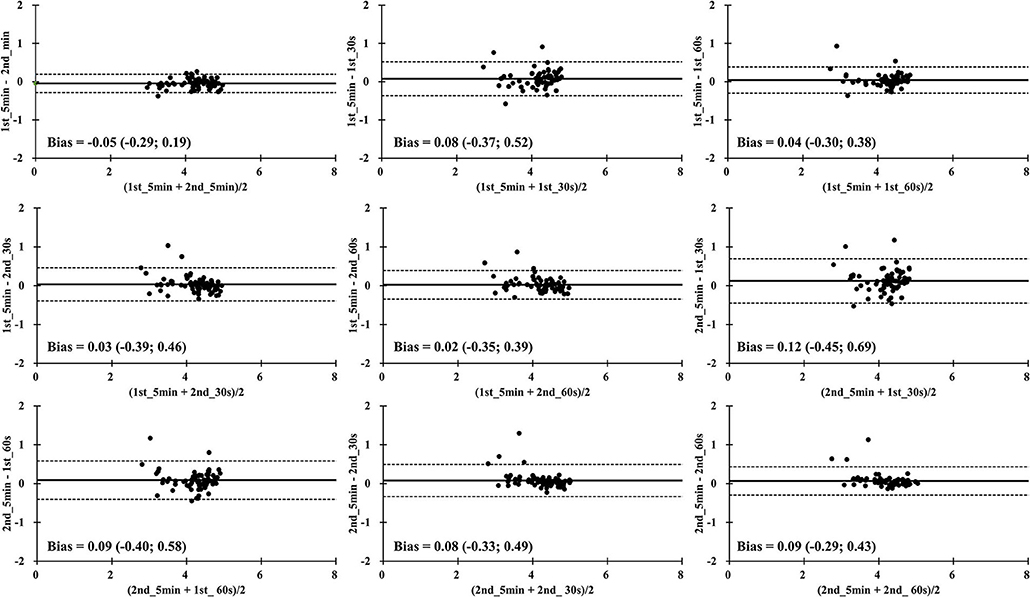
Figure 3. Bland-Altman plots for the mean of natural logarithm of the root mean square differences between adjacent normal R-R intervals in all time segments during four overseas training camps. 1st_5min = The first 5-min LnRMSSD; 1st_30 s = The first 30 s LnRMSSD; 1st_60 s = The first 60 s LnRMSSD; 2nd_5 min = The 6-10 min LnRMSSD; 2nd_30 s = The secondary 30 s LnRMSSD; 2nd_60 s = The secondary 60 s LnRMSSD.
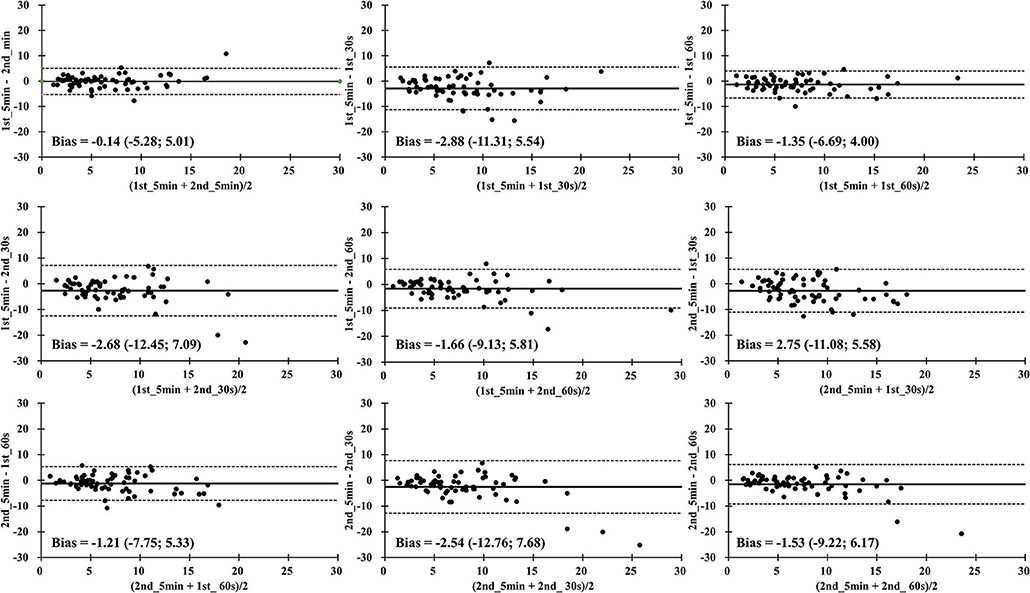
Figure 4. Bland-Altman plots for the coefficient of variation of natural logarithm of the root mean square differences between adjacent normal R-R intervals in all time segments during four overseas training camps. 1st_5 min = The first 5-min LnRMSSD; 1st_30 s = The first 30 s LnRMSSD; 1st_60 s = The first 60 s LnRMSSD; 2nd_5 min = The 6-10 min LnRMSSD; 2nd_30 s = The secondary 30 s LnRMSSD; 2nd_60 s = The secondary 60 s LnRMSSD.
Comparison of LnRMSSDmean and LnRMSSDcv Among Overseas Training Camps
The descriptive results of LnRMSSDmean and LnRMSSDcv for all time segments during four different overseas training camps are presented in Table 4. Collectively, pairwise comparisons showed trivial to small ES in LnRMSSDmean (0.02; 0.41 ES) and LnRMSSDcv (−0.02; −0.49 ES) across overseas training camps.
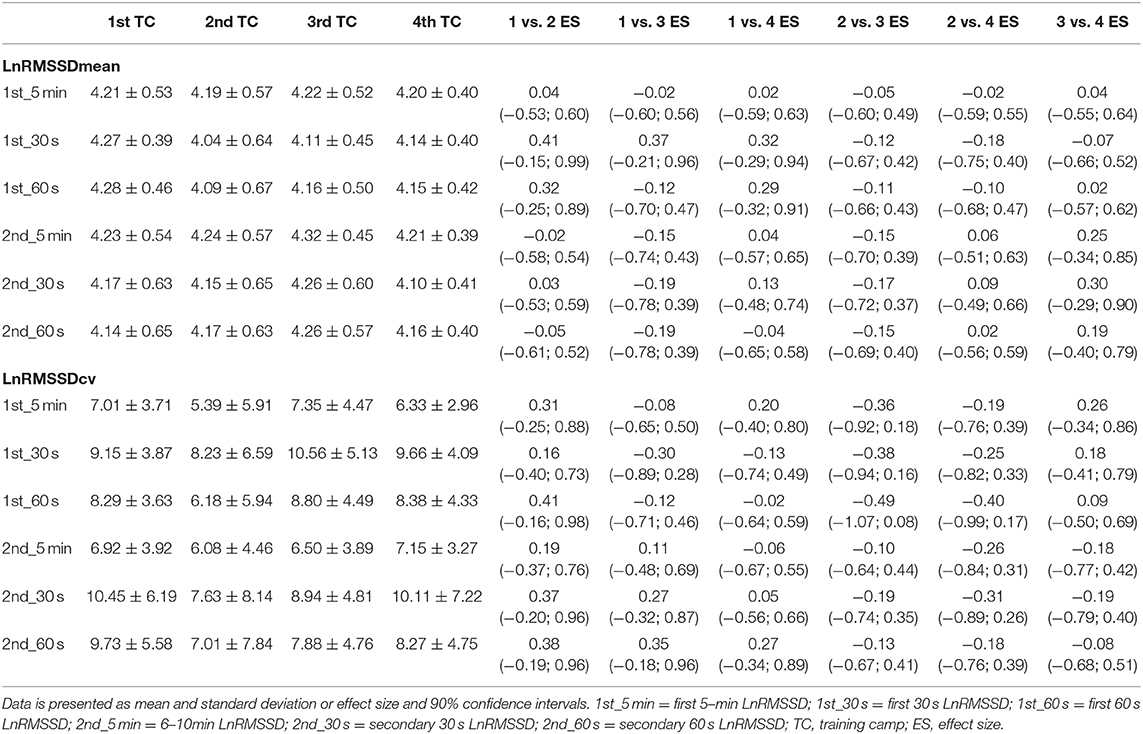
Table 4. Natural logarithm of the root mean square differences between adjacent normal R–R intervals (mean and coefficient of variation values) in first 30 s, first 60 s, and 5 min time segments during stabilization vs after stabilization in four overseas training camps.
Discussion
This study is the first to report the reliability and validity of HRVUST during a series of overseas training camps in male U-20 national team futsal players. The primary findings of the present study revealed that the 30 and 60 s HRVUST measure during stabilization and post-stabilization periods were valid and acceptable measures for LnRMSSD assessment and can be used as a surrogate for the standard 5-min recording. In addition, the secondary finding in the present study showed trivial to small levels of effect size in all time segments of LnRMSSDmean and LnRMSSDcv across overseas training camps.
Agreement and Reliability of Ultra-Short-Term Heart Rate Variability
The present study attempted to investigate the agreement of HRVUST assessment for cardiac-autonomic adaptation during and after the stabilization process. The results of LnRMSSDmean demonstrated trivial to small ES, very large to nearly perfect ICC, and narrow range of SEM (0.06–0.31) when all time segments of HRVUST were compared to the 1st_5 min and 2nd_5 min HRV. Furthermore, the magnitude of the correlation coefficients was nearly perfect when the 1st_5 min was compared to all the time segments (r = 0.90–0.97). In terms of agreement of HRVUST, we found that there was excellent acceptance in all time segments. Indeed, perfect agreement was found between the 1st_5 min and 2nd_5 min HRV comparison (narrow risk of bias and limits of agreement). These findings indicate an absence of stabilization prior to HRVUST measurement is acceptable for the accuracy of HRV measurement during overseas training camps. Our laboratory recently reported acceptance of 30-s HRVUST of LnRMSSDmean measure during short-term training camps in young adult futsal players (Chen et al., 2020). Nakamura et al. (2020) compared the limits of agreement between a standard 10 min LnRMSSD (5-min stabilization and 5-min HRV record) and LnRMSSDUST (1–2 min record followed by 1-min stabilization) in 11 male futsal players before and after 4-weeks of pre-season training. Nakamura's et al. study showed meaningful changes in HRVUST measures in response to a futsal pre-season (these results indicate a progressive increase in the vagal activity and reduction of training-induced perturbation of cardiac autonomic homeostasis over the futsal pre-season). Excellent agreement and reliability of HRVUST after 1 min stabilization has also been reported in athletic populations (Esco and Flatt, 2014; Nakamura et al., 2015; Flatt and Esco, 2016; Pereira et al., 2016). Our observation further supports the notion of implementing HRVUST recording by measuring weekly LnRMSSDmean during overseas training camps due to the very high and nearly perfect correlation coefficient and a narrow range of limits of agreement during all time segments. Indeed, all players in our study were familiarized with the procedure of HRV measurement in order to increase the accuracy of recording. Collectively, our findings demonstrate consistent excellent agreement of HRVUST of weekly LnRMSSDmean during overseas training camps without the conventional 5-min postural stabilization period recommended when LnRMSSD is used for HRV recording.
The results of LnRMSSDcv demonstrated trivial to large ES, small to very large ICC when HRVUST parameters were used to compare the 1st_5 min and 2nd_5 min HRV. In addition, high to very high correlations and a wide range of limits of agreement in all time segments of LnRMSSDcv comparisons were identified (Figures 2, 4). It seems that the shortened LnRMSSDcv recording less than 1 min may increase the bias of measurement. Our laboratory recently reported that HRVUST of LnRMSSDcv could not be used as a surrogate of 5 min standard HRV records during short-term training camps due to inaccuracy of measures (Chen et al., 2020). It is important to note that LnRMSSDcv increases in association with perception of fatigue and reduce of physical performance (Flatt et al., 2017a). Previous studies have demonstrated that 1-min LnRMSSDcv measure after 1-min postural stabilization is sensitive to physical adaptation in response to periodization of training loads in women soccer players (Flatt and Esco, 2015), rugby seven players (Flatt and Howells, 2019), sprint swimmers (Flatt et al., 2017b), and futsal players (Nakamura et al., 2020). Interestingly, in our study, 60 s HRVUST of LnRMSSDcv demonstrated better ICC values, magnitude of correlation coefficient, and agreement of measures than 30 s HRVUST of LnRMSSDcv despite stabilization or after stabilization period. Nevertheless, cautions should be taken when LnRMSSDcv are used to evaluate ANS adaptation during training camps.
Comparisons of LnRMSSDmean and LnRMSSDcv Among Oversea Training Camps
As demonstrated in Table 4, in comparison with LnRMSSDmean among overseas training camps, trivial ES was observed in 1st_5 min, 2nd_30 s, 2nd_60 s, and 2nd_5in time segments. In contrast, trivial to small ES in 1st_30 s and 1st_60 s time segments. Moreover, a wide range of ES between trivial and small levels were identified when LnRMSSDcv variable were compared across overseas training camps. It is argued that LnRMSSDmean should be used as a global marker to evaluate the training adaptation of vagal-related activities (Plews et al., 2013b). Whereas, LnRMSSDcv is sensitive to detect the daily variation of ANS adaptation to training workloads and psychophysiological conditions (Nakamura et al., 2020). Our laboratory recently reported that HRVUST of LnRMSSDcv after stabilization period demonstrated large bias and invalid results. In contrast, HRVUST of LnRMSSDmean was valid and reliable to the 5-min standard measure (Chen et al., 2020). However, LnRMSSDmean and LnRMSSDcv were only examined in ultra-short-term and standard time segments with/without stabilization in the present study. Nevertheless, trivial to small ES found in all pairwise comparisons indicated the patterns of LnRMSSDmean and LnRMSSDcv modulation are similar despite the various objectives of overseas training camps.
Limitations
The findings in the present study were limited by third factors. Firstly, the number of players vary from camps to camps. Longitudinal adaptation in vagal-related changes in relation to periodization was incomparable in this study Secondly, this study did not compare HRV responses to psychometric and physiological markers of training adaptation. Relationship between HRVUST measures and psychophysiological responses during overseas training camps should be established in future studies. Thirdly, time difference and traveling stress within the fourth overseas training camp may have caused a potential bias in the interpretation of the outcome of the studies. Other logistical issues such as the traveling itinerary, accommodation, accessibility of sports facilities, local transportation, and kit management have a critical effect on players' recovery status.
Practical Implication
It is understood that time management is a critical issue within training camps. The players require adequate rest time for recovery from the heavy burden of psychophysiological strains due to congested scheduling (i.e., training sessions, matches, meetings, dining, and additional team activities). These factors are considered when additional prerequisites such as medical checks, psychological consultations, rehabilitation, and training load monitoring are facilitated. The findings of this study suggest that HRV monitoring via HRVUST measures within the first minute could be applied to assess vagal-related changes during training camp.
Conclusion
In conclusion, either the first 30 or 60-s LnRMSSD recordings can be used to evaluate daily cardiac-autonomic functions during overseas training camps in futsal players. The process for stabilization seems to be unnecessary for measuring the morning resting LnRMSSD variable during overseas training camps in young adult futsal players. Consideration to use short HRVUST measures should be addressed due to the discrepancies of LnRMSSDcv between time segments. In addition, there is a trivial to small variation of weekly LnRMSSDmean and LnRMSSDcv across different overseas training camps. The observations in our study indicated specific characteristics of HRV modulation in U-20 futsal players during oversea training camps.
Data Availability Statement
The raw data supporting the conclusions of this article will be made available by the authors, without undue reservation.
Ethics Statement
The studies involving human participants were reviewed and approved by the Human Ethics Committee of the University of Taipei. Written informed consent to participate in this study was provided by the participants' legal guardian/next of kin.
Author Contributions
Y-SC contributed to the study conceptualization, project administration, investigation, data analysis, methodology, and writing (including reviewing and editing) of the manuscript. JCP and PB contributed to the study conceptualization, data analysis, and writing (including reviewing and editing) of the manuscript. ZC-M contribute to the study data analysis and writing (including reviewing and editing) of the manuscript. C-DK and FMC contributed to the study conceptualization, methodology, supervision, and writing (including reviewing and editing) of the manuscript. All authors contributed to the article and approved the submitted version.
Funding
This study was supported by the grant VN99-14 from the Taipei Veterans General Hospital-National Taiwan University Hospital Joint Research Program, Taipei, Taiwan.
Conflict of Interest
The authors declare that the research was conducted in the absence of any commercial or financial relationships that could be construed as a potential conflict of interest.
Acknowledgments
The authors would like to thanks the head coach Adil Amarante, team staff, and players of the U-20 Chinese Taipei Futsal team who volunteered for this study.
References
Bland, J. M., and Altman, D. G. (1986). Statistical methods for assessing agreement between two methods of clinical measurement. Lancet 327, 307–310. doi: 10.1016/S0140-6736(86)90837-8
Buchheit, M. (2014). Monitoring training status with HR measures: do all roads lead to Rome? Front. Physiol. 27:73. doi: 10.3389/fphys.2014.00073
Buchheit, M., Laursen, P. B., and Ahmaidi, S. (2007). Parasympathetic reactivation after repeated sprint exercise. Am. J. Physiol. 293, H133–H141. doi: 10.1152/ajpheart.00062.2007
Castaldo, R., Montesinos, L., Melillo, P., James, C., and Pecchia, L. (2019). Ultra-short term HRV features as surrogates of short term HRV: a case study on mental stress detection in real life. BMC Med. Inform. Decis. Mak. 19:12. doi: 10.1186/s12911-019-0742-y
Chen, Y. S., Clemente, F. M., Bezerra, P., and Lu, Y. X. (2020). Ultra-short-term and short-term heart rate variability recording during training camps and an international tournament in U-20 national futsal players. Int. J. Environ. Res. Public Health 17:775. doi: 10.3390/ijerph17030775
Chen, Y. S., Lu, W. A., Clemente, F. M., Bezerra, J. P., and Kuo, C. D. (2019). Increased parasympathetic activity by foot reflexology massage after repeated sprint test in collegiate football players: a randomised controlled trial. Sports 7:228. doi: 10.3390/sports7110228
Clemente, F. M., Silva, A. F., Sarmento, H., Ramirez-Campillo, R., Chiu, Y. W., Lu, Y. X., et al. (2020). Psychobiological changes during national futsal team training camps and their relationship with training load. Int. J. Environ. Res. Public Health 17:1843. doi: 10.3390/ijerph17061843
Esco, M. R., and Flatt, A. A. (2014). Ultra-short-term heart rate variability indexes at rest and post-exercise in athletes: evaluating the agreement with accepted recommendations. J. Sports. Sci. Med. 13, 535–541.
Flatt, A. A., and Esco, M. R. (2015). Smartphone-derived heart-rate variability and training load in a women's soccer team. Int. J. Sports Physiol. Perform 10, 994–1000. doi: 10.1123/ijspp.2014-0556
Flatt, A. A., and Esco, M. R. (2016). Heart rate variability stabilization in athletes: towards more convenient data acquisition. Clin. Physiol. Funct. Imaging 36, 331–336. doi: 10.1111/cpf.12233
Flatt, A. A., Esco, M. R., Nakamura, F. Y., and Plews, D. J. (2017a). Interpreting daily heart rate variability changes in collegiate female soccer players. J. Sports. Med. Phys. Fitness. 57, 907–915. doi: 10.23736/S0022-4707.16.06322-2
Flatt, A. A., Hornikel, B., and Esco, M. R. (2017b). Heart rate variability and psychometric responses to overload and tapering in collegiate sprint-swimmers. J. Sci. Med. Sport 20, 606–610. doi: 10.1016/j.jsams.2016.10.017
Flatt, A. A., and Howells, D. (2019). Effects of varying training load on heart rate variability and running performance among an olympic rugby sevens team. J. Sci. Med. Sport 22, 222–226. doi: 10.1016/j.jsams.2018.07.014
Flatt, A. A., Howells, D., and Williams, S. (2019). Effects of consecutive domestic and international tournaments on heart rate variability in an elite rugby sevens team. J. Sci. Med. Sport 22, 616–621. doi: 10.1016/j.jsams.2018.11.022
Hopkins, W. G., Marshall, S. W., Batterham, A. M., and Hanin, J. (2009). Progressive statistics for studies in sports medicine and exercise science. Med. Sci. Sport Exer. 41, 3–12. doi: 10.1249/MSS.0b013e31818cb278
Krejčí, J., Botek, M., and McKune, A. J. (2018). Stabilization period before capturing an ultra-short vagal index can be shortened to 60 s in endurance athletes and to 90 s in university students. PLoS ONE 13:e0205115. doi: 10.1371/journal.pone.0205115
Muñoz-López, A., Nakamura, F., and Naranjo, O. J. (in press). Soccer matches but not training sessions disturb cardiac-autonomic regulation during national soccer team training camps. Res. Q. Exerc. Sport. doi: 10.1080/02701367.2019.1708843. [Epub ahead of print].
Nakamura, F., Soares-Caldeira, L., Laursen, P., Polito, M., Leme, L., and Buchheit, M. (2009). Cardiac autonomic responses to repeated shuttle sprints. Int. J. Sports Med. 30, 808–813. doi: 10.1055/s-0029-1234055
Nakamura, F. Y., Antunes, P., Nunes, C., Costa, J. A., Esco, M. R., and Travassos, B. (2020). Heart rate variability changes from traditional vs. ultra–short-term recordings in relation to preseason training load and performance in futsal players. J. Str. Cond. Res. 34, 2974–2981. doi: 10.1519/JSC.0000000000002910
Nakamura, F. Y., Flatt, A. A., Pereira, L. A., Ramirez-Campillo, R., Loturco, I., and Esco, M. R. (2015). Ultra-short-term heart rate variability is sensitive to training effects in team sports players. J. Sports. Sci. Med. 14, 602–605.
Pereira, L., Flatt, A., Ramirez-Campillo, R., Loturco, I., and Nakamura, F. (2016). Assessing shortened field-based heart rate variability data acquisition in team-sport athletes. Int. J. Sport. Phys. Perform. 11, 154–158. doi: 10.1123/ijspp.2015-0038
Plews, D. J., Laursen, P. B., Kilding, A. E., and Buchheit, M. (2013a). Evaluating training adaptation with heart-rate measures: a methodological comparison. Int. J. Sport. Phys. Perform. 8, 688–691. doi: 10.1123/ijspp.8.6.688
Plews, D. J., Laursen, P. B., Stanley, J., Kilding, A. E., and Buchheit, M. (2013b). Training adaptation and heart rate variability in elite endurance athletes: opening the door to effective monitoring. Sports Med. 43, 773–781. doi: 10.1007/s40279-013-0071-8
Sandercock, G. R. H., Bromley, P. D., and Brodie, D. A. (2005). Effects of exercise on heart rate variability: inferences from meta-analysis. Med. Sci. Sport. Exer. 37, 433–439. doi: 10.1249/01.MSS.0000155388.39002.9D
Tarvainen, M. P., Niskanen, J. P., Lipponen, J. A., Ranta-aho, P. O., and Karjalainen, P. A. (2014). Kubios HRV – heart rate variability analysis software. Comput. Meth. Prog. Biomed. 113, 210–220. doi: 10.1016/j.cmpb.2013.07.024
Task Force of the European Society of Cardiology and the North American Society of Pacing and Electrophysiology. (1996). Heart rate variability: standards of measurement, physiological interpretation, and clinical use. Circulation 93, 1043–1065. doi: 10.1161/01.CIR.93.5.1043
Keywords: heart rate variability, autonomic nervous system, overseas training camps, futsal training, ultra-short-term recording
Citation: Chen Y-S, Pagaduan JC, Bezerra P, Crowley-McHattan ZJ, Kuo C-D and Clemente FM (2021) Agreement of Ultra-Short-Term Heart Rate Variability Recordings During Overseas Training Camps in Under-20 National Futsal Players. Front. Psychol. 12:621399. doi: 10.3389/fpsyg.2021.621399
Received: 26 October 2020; Accepted: 12 January 2021;
Published: 05 February 2021.
Edited by:
Fábio Yuzo Nakamura, Instituto Universitário da Maia (ISMAI), PortugalReviewed by:
Andrew A. Flatt, Georgia Southern University, United StatesCesar Cavinato Cal Abad, Faculdade Lusófona de São Paulo, Brazil
Copyright © 2021 Chen, Pagaduan, Bezerra, Crowley-McHattan, Kuo and Clemente. This is an open-access article distributed under the terms of the Creative Commons Attribution License (CC BY). The use, distribution or reproduction in other forums is permitted, provided the original author(s) and the copyright owner(s) are credited and that the original publication in this journal is cited, in accordance with accepted academic practice. No use, distribution or reproduction is permitted which does not comply with these terms.
*Correspondence: Cheng-Deng Kuo, Y2RrdW8yM0BnbWFpbC5jb20=; Filipe Manuel Clemente, ZmlsaXBlLmNsZW1lbnRlNUBnbWFpbC5jb20=
 Yung-Sheng Chen
Yung-Sheng Chen Jeffrey C. Pagaduan
Jeffrey C. Pagaduan Pedro Bezerra
Pedro Bezerra Zachary J. Crowley-McHattan
Zachary J. Crowley-McHattan Cheng-Deng Kuo
Cheng-Deng Kuo Filipe Manuel Clemente
Filipe Manuel Clemente